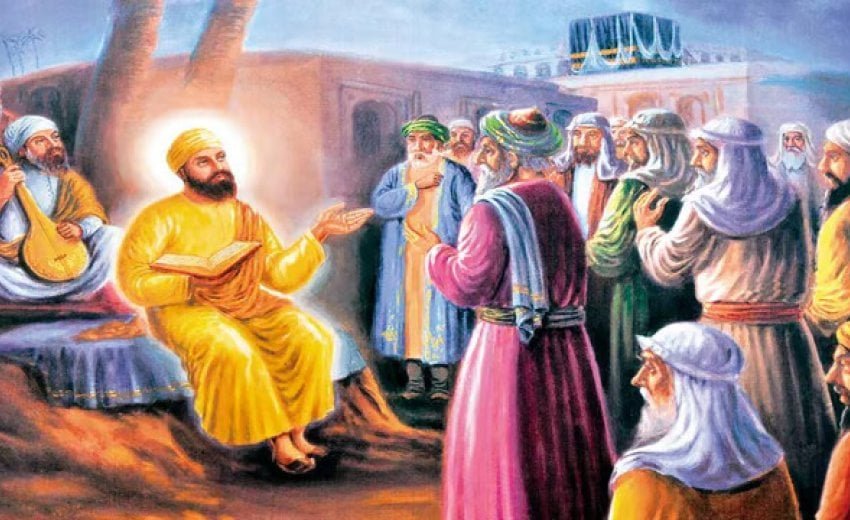The connection between Sufism and Sikhism can be traced back to the times of Guru Nanak, who lived from 1469 to 1539.
The connection between Sufism and Sikhism can be traced back to the times of Guru Nanak, who lived from 1469 to 1539. Guru Nanak led a life characterized by simplicity and deep spiritual dedication. He focused on fostering love, tolerance, peaceful coexistence, and harmony among people of various faiths and socioeconomic backgrounds. The Guru was so deeply immersed in piety and in teaching his followers to live spiritually, honestly, and harmoniously that many of his Muslim contemporaries, particularly Sufis, regarded him as a true Muslim.
Guru Nanak undertook extensive travels, including pilgrimages to Mecca for Hajj, various regions of Afghanistan, and Baghdad, in pursuit of divine knowledge and mystical scholarship. These journeys exposed him more to Islam and its diverse mystical schools of thought than to any other religion. For 64 years, one of Guru Nanak's closest companions and attendants was Mardana, who remained a Muslim until his death. The custodian of Miyan Mir's shrine in Lahore reports that Mardana's descendants still reside there and identify themselves as Sikh-Muslims.
Shrine of Guru Nanak
Upon his death, Guru Nanak left behind a large number of Hindu and Muslim disciples, each side claiming him as theirs, for he had lived with them so harmoniously and treated them so equally, so respectfully, and so sincerely that neither side was willing to give up his body to the other. Today, Guru Nanak's shrine attracts not only Sikhs but also Hindus and Muslims, who seek his blessings in their own unique ways.
The spiritual connection between Sufism and Sikhism grew stronger over time. This relationship was exemplified when Guru Arjan Dev invited Miyan Mir, a prominent Sufi of the Qaderi Order, to lay the foundation stone of the Golden Temple in Amritsar, Punjab. The Gurus and Sufis taught their followers values and principles that shared a deep focus on humanism. This commonality is evident in the Guru Granth, the central religious text of Sikhism, which includes 112 couplets and four hymns by Khwaja Fariduddin Ganjshakar, a renowned Sufi of the Chishti Order who lived in Punjab from 1173 to 1266. This inclusion highlights the profound connection between Sufism and Sikhism and their mutual influence on each other.
The differences between Sikh and Muslim communities since Sikhism's emergence in the 15th century have been largely attributed to political realities rather than spiritual principles. Both Sufis and Sikh Gurus followed similar paths to seek truth by serving God's representatives on earth, promoting love, tolerance, and mutual aid.
Afghanistan, birthplace of many notable Subcontinent Sufis, including Khwaja Moinuddin Chishti, has proposed a sister-city relationship between Chisht in Herat and Ajmer in Rajasthan. This initiative aims to honour Chishti's legacy and strengthen cultural ties between Afghanistan and India, acknowledging their shared history and interconnected future. Chishti, born in Chisht around 1141, eventually settled in Ajmer following what he believed to be divine guidance.
The Chishti Order of Sufism, which influenced Guru Nanak's teachings, emphasized human service in its interpretation of religion. It encouraged followers to embody generosity like a river, affection like the sun, and hospitality like the earth. Chishti believed the highest form of devotion involved alleviating others' distress, helping the helpless, and feeding the hungry.
To put these principles into practice, Sufis established khanaqas - community centers providing food, lodging, spiritual guidance, and counseling - in rural areas across India. These centers, particularly those of the Chishti Order, welcomed all regardless of faith, race, or caste. By fostering egalitarian communities within a stratified society, Sufis effectively spread their teachings of love, spirituality, and harmony, attracting many to Islam through their example of brotherhood and equality.
Revisiting the Basic Precepts
The principles of Sufism and Sikhism offer guidance for restoring peace and harmony in South Asia today. In our increasingly interconnected world, nations should dismantle barriers of animosity, hostility, and counterproductive zero-sum strategies aimed at undermining each other. These man-made obstacles to collective progress should be replaced by sincere, outcome-focused efforts to achieve regional integration for universal peace and prosperity. This aligns with the teachings of the great Sufis and Gurus of Central and South Asia, who advocated for replacing human tragedy with harmony through universal service and brotherhood under a benevolent, merciful God manifested in many beautiful forms.
The 2023 Summit of the South Asian Association for Regional Cooperation (SAARC) in Kathmandu, Nepal, focused on the shared challenges facing South Asian nations. Despite the region's rich natural and cultural heritage, its people continue to suffer from extreme poverty, weak governance, insufficient connectivity and energy resources, and security threats. Afghan President Ashraf Ghani urged his fellow SAARC leaders to address these issues' root causes and harness the region's vast natural and human potential for collective security and prosperity. He called for a shift from confrontation to cooperation among nations, describing it as changing the rules of the game and the playing field.
Ghani said that South Asian countries need to stop thinking in terms of winners and losers. He believed this mindset was holding them back from developing together. He said changing this way of thinking was a test of leadership. Ghani suggested that South Asia needs leaders like Guru Nanak. Guru Nanak led by example, bringing together Hindus and Muslims. He made his followers forget about their differences in ethnicity, faith, and caste. Instead, he united them around ideas that helped everyone.
One should look at what Ishlam stands for, as communicated by another great Sufi-poet of the region, Saadi Shirazi:
Human beings are members of a whole,
In creation of one essence and soul.
If one member is afflicted with pain,
Other members uneasy will remain.
If you’ve no sympathy for human pain,
The name of human you cannot retain!
*Based on an article by M. Ashraf Haidari, published in sikhfoundation.org on 12th August 2015
